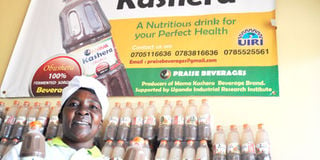Grinding cash from millet

Betty Kasiriri Businge displays some of the products she makes through value addition at her farm in Kira. Photo by Beatrice Nakibuuka
Zubair Kawooya a resident of Bukolooto Village, Kayunga Town, in Kayunga District was a poor man three years ago.
He was previously a maize farmer and it is from selling dry maize grain that he derived his livelihood.
“I used to earn about Shs450,000 from my maize every season because I was being cheated by middlemen,” Kawooya, 43 recounts.
Numa processing plant
Did you know you may be paid less for your freshly harvested millet? However, adding value to the millet like any other grains can fetch you more money because you are improving the product.
Betty Kasiriri Businge is a resident of Kamuli village in Kira, Wakiso District is the mind behind Mama Kashera, a beverage got by adding value to millet.
The mother of four started making the millet drink eight years ago to provide for her family when her husband got injured in an accident.
With the drink, she was able to feed and support the family while she nursed her husband’s wounds.
Innovation
It was not hard for her to start since her mother had taught her how to make the drink while she was a child. “I grew up seeing my mother make bushera so I learnt how to make the millet drink,” she says.
At the time she started making the millet drink, she was not adding preservatives so she would incur losses because it would ferment when it remained unsold overnight. She sold 500ml for as little as Shs500.
“Hot days were terrible for me because I made huge losses,” says Kasiriri before adding “When the bushera remained, it would ferment and people would not buy it so I would pour it.”
A friend then told her about a training programme at Uganda Industrial Research Institute (UIRI)
where she was able to learn how to use preservatives to add shelf life.
“It took me some months to learn how to do it well because I had to apply what I had been taught,” says Businge.
Adding preservatives
“Preserving would keep the drink for six months without fermenting and when I revamped the business, I used
capital worth Shs100,000 and had to get extra workers who would help in packaging,” she explains.
She now sells a 500ml bottle of Mama Kashera at Shs1,000. In a good week, she records a turnover of more than 40 cartons of bushera which she supplies to schools and supermarkets within Wakiso District. She says she does not incur high transportation costs given the fact that her processing unit is within the vicinity of the market.
Her bushera has passed the biology and chemistry tests of the research institute and is close to getting an S mark from Uganda National Bureau of Standards.
From adding value to millet, she earns Shs1.5m a month. She buys millet from the farmers in western Uganda especially the districts of Ibanda and Mbarara.
Peter Kugonza of Bweyogerere is the other farmer producing Pour boiling water into the paste and stir very fast to make porridge without lumps.
Let it settle for 15 minutes.
Now you can add the sprouted millet flour which will make the juice sweet.
Stir evenly to mix and cover tightly in a bucket.
Let it stay for a night and it will be ready to drink.
Pour it in a jerrycan or a jar and store it in a fridge.
Millet porridge is easy to make because one can just mix the flour first cold water to make a paste and later with boiled water. You may add brown sugar, ginger and ready to eat.
The same flour can be used to make a millet meal locally known as kalo (millet paste) which is a delicacy for so many people in Uganda.
Sometimes it is mixed with cassava or sorghum flour to make a nutritious meal.
According to Bridget Kezaabu, a nutritionist, millet is a good source of gluten-free fibre and contains alkaline which is good for calming the nervous system.
She says, “Millet is a very healthy cereal which is very high in starch and a good source of vitamins, minerals, and organic compounds that can significantly boost the body’s immunity in various ways. It is also loaded with magnesium, calcium, manganese, phosphorus, fibre, B vitamins and antioxidants.”




